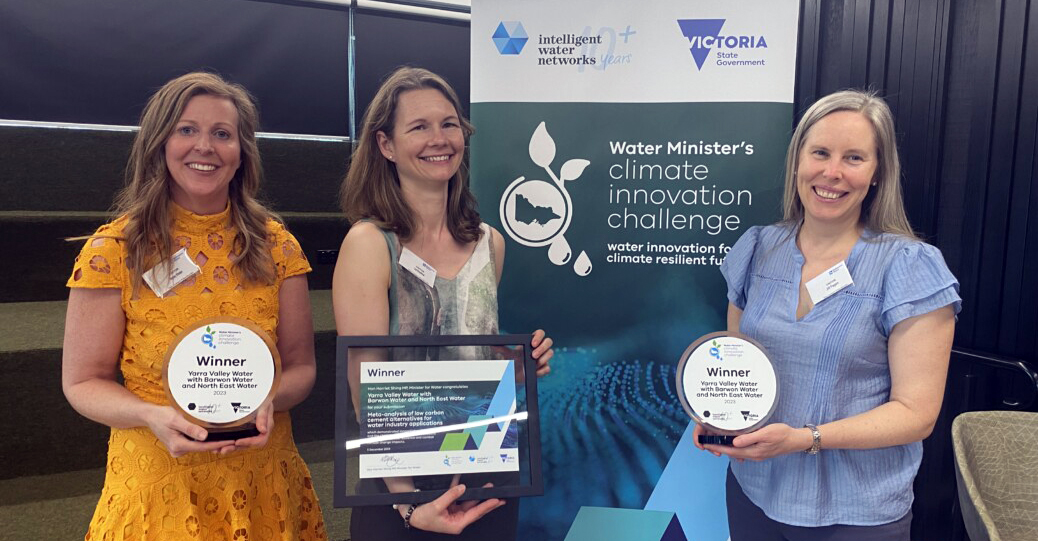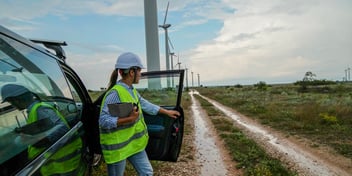Victorian utilities collaborate on low-carbon cement to reduce emissions

An innovative project between three Victorian water utilities is underway to find low-carbon alternatives to cement in a bid to help reduce the carbon footprint of infrastructure construction.
Winner of the Victorian Minister’s Climate Innovation Challenge 2023, the project is a collaboration between Yarra Valley Water, North East Water and Barwon Water.
The project aims to identify and examine the suitability of low-carbon cement alternatives for use in applications specific to the water sector, and ultimately speed up the process of integrating greener alternatives into wide-scale use.
Leading the project team are Dr Lisa Ehrenfried from Yarra Valley Water, Hayley Vinden from Barwon Water and Dr Jill Fagan from North East Water.
Yarra Valley Water Managing Director Pat McCafferty said cement is a major contributor to greenhouse gas emissions globally, and is used extensively within the water sector to build pipes, water tanks and treatment plants.
“Cement, a key ingredient in concrete, is responsible for about 8% of the world’s carbon emissions – that’s far more than global emissions from aviation,” he said.
“Tackling our construction works’ carbon footprint is one of the biggest innovation opportunities for the water sector to reduce emissions.”
Yarra Valley Water Environment & Community Resilience Manager Dr Lisa Ehrenfried said the initiative is a game changer, not just for reducing emissions involved in construction, but also for protecting the environment.
“By pioneering low-carbon alternatives in the water industry, we’re leading a vital charge against climate change,” she said.
“The world is currently off track to 2.5C warming, so it is crucial we reduce carbon emissions wherever possible. It's about redefining norms, reducing emissions, and paving the way for a more sustainable future for generations to come.”
Tackling emissions
North East Water Manager Planning & Liveability Dr Jill Fagan said meeting incoming carbon reduction targets will require new approaches to how the water sector works.
“Victoria’s water sector contributes 1% of the state’s total carbon emissions, and with a commitment to achieving net-zero emissions by 2035, innovative projects like this are essential in meeting that target,” she said.
“Traditional cement is produced in very high temperature kilns, which release a lot of carbon dioxide. This project team will look at low-carbon cement options that are made using less heat or can make use of industrial waste products, to reduce emissions.
“The initiative aims to fast-track the uptake of low-carbon cement products within the water sector, potentially becoming a blueprint for the Australian water industry.”
Ehrenfried said the project is focusing on cement in order to help curb Scope 3 emissions, which is a notoriously difficult carbon profile to reduce.
“In the water industry, we've got some really great targets and solutions on how we reduce our Scope 1 and Scope 2 greenhouse gas emissions,” she said.
“But there are still a lot of emissions embedded in the construction process. And those Scope 3 emissions are immense.
“The good news is that there is really a big opportunity to further reduce the industry's carbon footprint by choosing the right materials. Low-carbon cement alternatives could reduce emissions from cement by up to 50%.”
Work ahead
While the project will consider the suitability of available alternatives for the water sector, Ehrenfried said there’s work to be done in terms of understanding and considering approvals for the use of new cement materials.
“In the water industry, we're building long-lasting, critical assets. We want to make sure these assets meet our standards – with some assets in contact with drinking water or the corrosive environment of sewers,” she said.
“Lots of water tanks are made from concrete, so we need to ensure the materials being introduced are appropriate for that application.
“There are alternatives available on the market. Many of the large local concrete manufacturers have some more environmentally friendly products with very high sustainability standards. It’s really about making sure these alternative cement products are suitable for our water-sector specific applications.”
The team intends to identify the criteria for concrete required within the water industry and identify the existing products on the Australian market and overseas that meet those criteria, Ehrenfried said.
“The Melbourne Retail Water Agencies Portal lists all of the products that are approved for use on our construction sites,” she said.
“While there's a long list of materials and products that are approved, there are no low-carbon cement products on there. Our first goal will be to identify a couple of products we can safely apply for certain applications.”
Benefits of collaboration
It makes sense for utilities to collaborate on new and innovative solutions to common problems, Ehrenfried said, with the diversity of insight and thinking set to create a more useful outcome for the broader sector.
“Jill, Haley and I, we are not lone operators, but there is only one person that fills our role within each of our utilities. It's really great to have peers to collaborate with on finding these new opportunities,” she said.
“We each have our networks and our expertise to tap into, and three brains are always better than one. It’s valuable for us to be sharing our different perspectives.
“Having both regional and metropolitan utilities involved will help us cover multiple contexts, and will therefore be more valuable for the wider industry, too.”
Barwon Water’s Hayley Vinden said the team hopes the project will catalyse low-carbon cement uptake within the water sector, but also more broadly across other regions and industries.
“We’re encouraged to think big and make a positive impact on the water sector, and this project will do just that to help reduce the industry’s carbon emissions,” she said.



